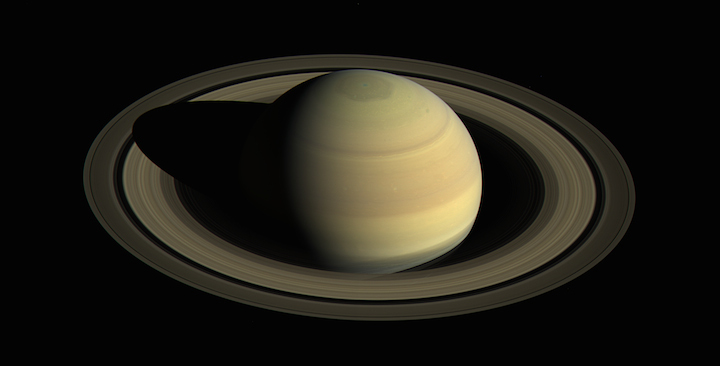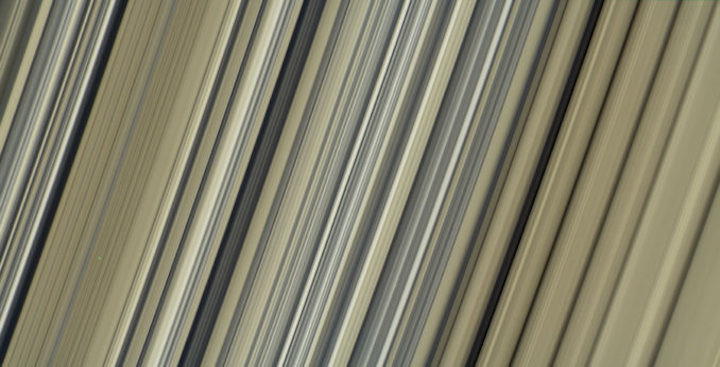21.10.2017

Scientists examining data from the Cassini mission’s final months reported this week unexpected measurements of Saturn’s gravity field and outer atmosphere, suggesting they may have to revisit theories about the planet’s rings and the forces that generate magnetic fields.
Presenting an update at the American Astronomical Society’s Division for Planetary Sciences meeting in Provo, Utah, researchers said Monday that NASA’s Cassini spacecraft yielded unforeseen results as it repeatedly looped between Saturn and its rings during the final four months of the nearly 20-year mission.
“We’ve been analyzing the grand finale data, and there are lots of surprises,” said Linda Spilker, Cassini’s project scientist at NASA’s Jet Propulsion Laboratory. “Saturn, its rings, and the region in between are not what we expected.”
Thirteen years since it braked into orbit around Saturn, Cassini made 22 passes through the gap between planet and its rings between late April and Sept. 15. Ground controllers intentionally guided the plutonium-powered probe toward a destructive dive into the planet’s hydrogen atmosphere last month.
Scientists devised Cassini’s final act to collect new measurements of Saturn’s atmosphere, and gather data on the planet’s gravity and magnetic fields, which they expected to provide insights about the inner structure of Saturn, including the size and nature of its core.
Michele Dougherty, a researcher from Imperial College London, said Cassini’s instruments helped refine estimates of the tilt of Saturn’s magnetic field, revealing it to be closely aligned with the planet’s rotation axis.
“The real surprise is turning out to be the fact that the tilt between the rotation axis of the planet and the dipole axis is really small,” Dougherty said.
Scientists knew the rotation and magnetic field axes were in tight alignment, predicting before Cassini’s newest measurements that they were separated by less than 0.6 degrees. Now they estimate the tilt is less than 0.06 degrees.
Magnetic fields on Earth and Jupiter are produced by dynamos deep inside the planets, where conducting fluid under heavy pressure generates an electric current, helping propagate a field that extends outside the planets’ atmospheres, creating a magnetic bubble responsible for producing auroras and shielding from solar and cosmic radiation.

Earth’s dynamo uses liquid iron to generate its magnetic field. Dynamos inside gas giants like Jupiter and Saturn are believed to rely on hydrogen compressed under the force of several million atmospheres and stripped of their electrons, making it behave like a metal.
Conventional thought on dynamos inside Earth and Jupiter suggest they require a tilt between the rotation and magnetic field axes. Earth’s dipole is oriented around 11.5 degrees from its rotation axis, and Jupiter’s differs by about 10 degrees.
Mathematical models indicate a planet’s magnetic field would wither if the axes were aligned, dying within around 100 million years instead of persisting through the solar system’s 4.5-billion-year history.
“The fact that we haven’t been able to measure this tilt yet — we know that it’s really very small — points to the fact that there’s much more sophisticated dynamics taking place inside Saturn than we thought,” Dougherty said.
Once they complete their detective work, Dougherty said scientists will have a better idea of the size of Saturn’s core, and the source of the magnetic field.
“My understanding is that we’re going to change our minds about planetary dynamos,” she said.
Cassini’s magnetic field measurements during the mission’s grand finale orbits were four times more sensitive than before, Dougherty said.
“By getting inside the rings … we were away from the currents being generated by the rings — currents being generated in the environment around Saturn — (and) it is allowing us to focus on the signal coming from the interior.”
The data will also help scientists sort out the rotation rate of planet’s interior, telling them the exact length of a day on Saturn. The best estimate today suggests a Saturn day lasts around 10.8 hours.
Cassini’s ion and neutral mass spectrometer sampled Saturn’s atmosphere as the spacecraft barreled inside the rings. The atmosphere’s tenuous outer layers extend out almost to the rings, and Cassini discovered molecules raining down from the rings onto Saturn.

Scientists expected to find evidence of ring material in Cassini’s first-ever direct measurements of the atmosphere, but the spacecraft detected unexpectedly high levels of methane.
They predicted most of the molecules to be water because that makes up the bulk of the particles in the rings.
Methane should not persist in Saturn’s rings or in the planet’s outer atmosphere, said Mark Perry, an associate scientist on the ion and neutral mass spectrometer team.
“What we’re seeing are things that come from the rings, and methane is highly volatile,” Perry said. “Even if it’s in the rings, it shouldn’t last very long, and none of the models — none of the analyses — predicted methane, let alone in this abundance.”
Cassini also found the expected water molecules in the outer atmosphere, but the methane was a surprise.
“We think the water is there,” Perry said. “What we can’t explain is why it is not much more than anything else. That’s the confusing part.”
Cassini’s narrow-angle imaging camera obtained close-up views of intricate structures inside Saturn’s rings during the mission’s final months. One new mosaic recorded by Cassini in May shows the rings emerging from behind Saturn’s hazy limbs, with the rings’ shadows projected on the planet’s atmosphere.
Before it zipped through Saturn’s ring gap, Cassini was on a trajectory that grazed the outer edge of the rings on each orbit.
The spacecraft took pictures of features dubbed propellers — wakes created by tiny moons that would have otherwise gone undetected. The moonlets embedded inside Saturn’s rings leave a distinguishing mark, disturbing nearby particles as they sail around the planet.
“These are important because this is a window into planetary formation processes,” said Matthew Tiscareno of the SETI Institute. “What happens when big solar systems are forming is that you start to get the seed of a planet, but it’s embedded in a disk. So the disk is affecting the embedded mass, but the embedded mass is also affecting the disk, and we want to know more about what happens in both directions, and propellers give us a window into that.”

Tiscareno said scientists identified propellers with two classes of moonlets — some a few hundred meters in size and some around a kilometer (0.6 miles) across.
One primary objective of Cassini’s grand finale was to determine the mass, age and origin of Saturn’s rings.
Cassini’s position close to Saturn in the last few months allowed the probe’s instruments to sort out the difference between the pull of gravity from the planet and the rings.
If the rings are more massive, scientists think they could be old, perhaps as old as Saturn itself. A result indicating less massive rings would point to a more recent origin, perhaps when a moon or comet got too close to Saturn and was ripped apart.
The initial results suggest the rings are slightly less massive than expected, Spilker said, but uncertainty remains in the measurements. Scientists still must calculate the strength of Saturn’s gravity field from data downlinked from Cassini and remove the effect of atmospheric drag from the measurements.
“Once we resolve Saturn’s gravity field, we’ll have a better handle then on the mass of the rings,” Spilker said.
A new study based on Cassini data shows that the gravitational pull from several of Saturn’s moons combine to keep Saturn’s rings from spreading out and disappearing.
Scientists thought the small moon Janus single-handedly kept the rings in check, but measurements of the masses of Saturn’s moons and detailed images of waves in the rings led to a conclusion that seven moons — Pan, Atlas, Prometheus, Pandora, Janus, Epimetheus and Mimas — work together to keep the outer A ring from extending farther from Saturn.
Radwan Tajeddine of Cornell University led the study investigating the relationship between Saturn’s moons and rings.
“If these moons weren’t working together, then the A ring would have spread out over hundreds of millions of years, and the A ring would be gone,” Spilker said.
Meanwhile, engineers have assessed how the Cassini spacecraft behaved in its final moments plunging into Saturn’s atmosphere.
Launched 20 years ago this week, Cassini was traveling through the rarefied outer layers of Saturn’s atmosphere as it beamed back its last data to Earth, speeding through gas with about the same density that as encountered by the International Space Station as it soars 250 miles (400 kilometers) above Earth, according a NASA press release.
But Cassini was moving four-and-a-half times faster than the space station, multiplying the aerodynamic forces, officials said.
Cassini encountered Saturn’s atmosphere as it reached a point around 1,200 miles (3,600 kilometers) above the cloud tops. Atmospheric particles began pushing on Cassini’s 36-foot-long (11-meter) magnetometer boom.
The spacecraft fired thrusters to damp its rotation, using its jets for longer and more frequent pulses as it fell deeper into the atmosphere, according to NASA.
“With its thrusters firing almost continuously, the spacecraft held its own for 91 seconds against Saturn’s atmosphere — the thrusters reaching 100 percent of their capacity during the last 20 seconds or so before the signal was lost,” officials wrote in a press release. “The final eight seconds of data show that Cassini started to slowly tip over backward.”
Engineers programmed Cassini to broadcast science data and telemetry in real-time during its final moments, rather than storing the information on recorders for later playback.
Tracking antennas on Earth lost lock with Cassini’s dish-shaped antenna as the spacecraft turned away. A radio carrier signal continued streaming down from the probe for 24 more seconds, then it went silent.
“Given that Cassini wasn’t designed to fly into a planetary atmosphere, it’s remarkable that the spacecraft held on as long as it did, allowing its science instruments to send back data to the last second,” said Earl Maize, Cassini project manager at JPL. “It was a solidly built craft, and it did everything we asked of it.”
Quelle: SN
